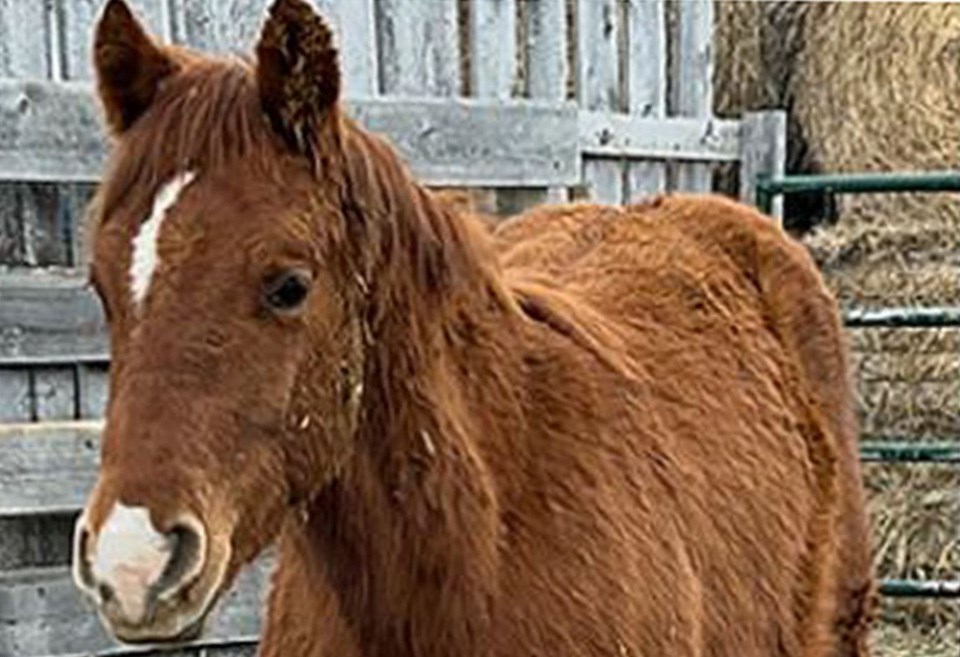HEPBURN — A 14-month-old sorrel stud colt went missing from the Hepburn area under suspicious circumstances. The colt was last seen by the owner on June 14.
It carries the unique markings of a partial moon on the forehead and a snipe on the nose. The owner has completed thorough checks of the surrounding area and inquiries with neighbours. The colt does not carry a brand.
While some reports of missing livestock turn out to be criminal, many are simply logistical mix-ups. Animals find a broken fence, employees make mistakes and sometimes, cows, calves or horses end up in the wrong pasture or running free on hectares of unsupervised land. This does not appear to be the case in this instance.
“I’d say about 100 to 150 reports of missing livestock come in per year,” Garth Woods, Livestock Services of Saskatchewan operations manager and brand inspector, shared in an article that appeared on discovermoosejaw.com in May of this year.
“Most of them are five to six head and a lot of those turn out to be innocent. But when cattle are worth what they are today, producers aren’t willing to take the risk on an investment like that. They report it right away.”
Livestock Services of Saskatchewan is responsible for issuing livestock brands, transferring the ownership of registered brands and maintaining the brand registry. It is owned and operated by the five main livestock producer groups requiring inspection services: Saskatchewan Cattlemen's Association, Saskatchewan Stock Growers Association, Saskatchewan Cattle Feeders Association, Saskatchewan Horse Federation, and Livestock Marketers of Saskatchewan Association. The provincial government continues to be responsible for legislation that governs livestock inspections, but the authority to carry out the duties of that legislation was transferred to LSS on Jan. 1, 2014. Ministry staff responsible for livestock inspection services at that time were transferred to the new organization.
LSS provides Saskatchewan Livestock Producers with a cost-effective and financially sustainable service. Its operations rely on revenue generated from services provided and is not government-funded. Through its efforts to become a Western Canadian industry leader in technology and best management practices, it develops effective collaborative relationships with neighbouring jurisdictions to facilitate secure livestock commerce. LSS is based out of its headquarters in Regina and has a province-wide network of 66 inspectors operating out of a variety of office locations, primarily auction markets. LSS operates under the authority of The Animal Products Act and The Animal Identification Act.
While actual confirmed theft is rare, fraud, and what is called harbouring, keeping livestock that is not yours, is a growing issue. Harbouring involves knowing that another’s livestock are in with one’s own herd and ‘turning a blind eye’ to it and letting them remain where they are instead of returning them.
A permanent, reliable method of identification makes it easier to confirm their identity if livestock is ever displaced by a natural disaster, such as a wildfire or tornado, by vandalism, such as a cut fence, or through an accidentally broken fence. Branding is one method of identifying a producer’s livestock and is thought to be an effective theft deterrent. Hot branding is the oldest known form of livestock identification. Hot branding is carried out by burning the animal’s skin with heated metal, while freeze branding creates a permanent mark by applying a branding iron that has been chilled in liquid nitrogen or alcohol and dry ice, which changes the colour of the hair or destroys the hair cells. Branding is the most common source of identification used on cattle. A livestock tattoo, another common method used in purebred animals, is a series of letters and numbers that are applied to the inside of a horse’s upper lip or inside a cattle’s ear using a series of inked plates with multiple needles dipped in ink.
For horses, some owners use a microchip inserted via a needle into the nuchal ligament that runs along the top of a horse’s neck as another option. Unless horses are going to be competing or sold, the average horse owner may not have any method of identifying their horse other than its physical markings. Identification in the form of microchips or tattoos, which are not readily visible, makes it more of a challenge to identify missing animals, but they are better than nothing as a source of identity confirmation.
If anyone has information related to this case, please call the local RCMP Detachment or Livestock Services Saskatchewan at 306-546-5086.


.png;w=120;h=80;mode=crop)
.png;w=120;h=80;mode=crop)
